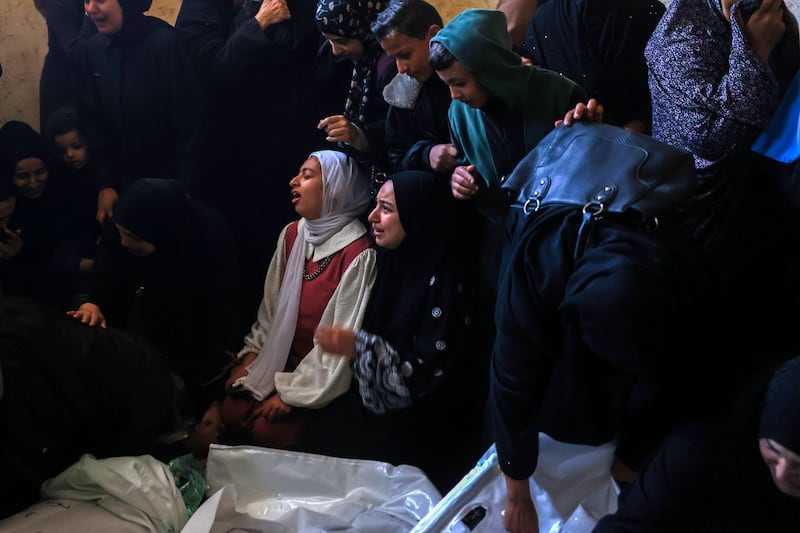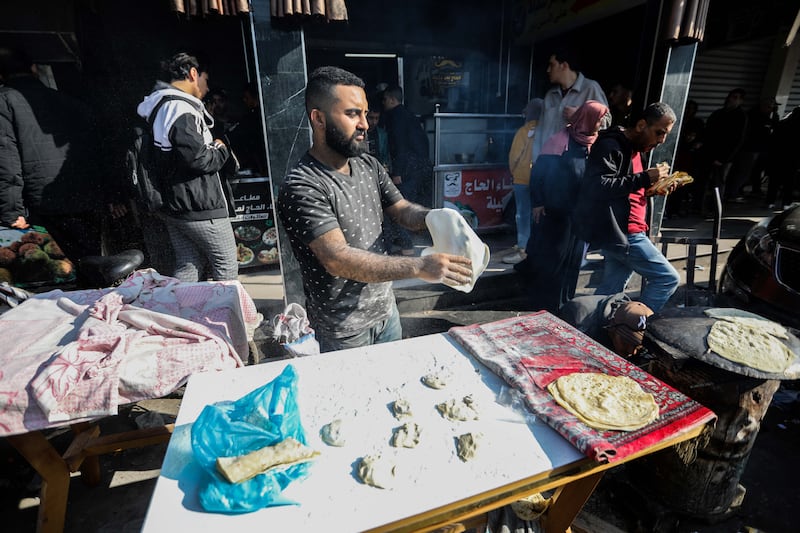Walaa Zaiter’s four children have been hungry for weeks, but she can barely find them food.
They ask for sandwiches, fruit juice and home-made Palestinian dishes like she used to cook before the war began. In a fleeting moment of internet access, she said, she once caught the children huddled around her phone watching a YouTube video of someone eating French fries.
In a recent telephone interview, she said the most they can hope for these days is a can of peas, some cheese and an energy bar distributed as a family’s rations by the United Nations once a week in Rafah, a city in the southern Gaza Strip to which they fled in early December to escape Israeli bombardment further north. It is not nearly enough to feed her family of seven, however.
“It’s a daily struggle,” said Zaiter (37), whose children range in age from nine months to 13 years. “You feel you are under pressure and hopeless, and you cannot provide anything.”
READ MORE
Israel’s war in Gaza has created a humanitarian catastrophe, with half of the population of about 2.2 million at risk of starvation and 90 per cent saying they regularly go without food for a whole day, the United Nations said in a recent report.
Arif Husain, chief economist at the World Food Programme, said the humanitarian disaster in Gaza was among the worst he had ever seen. The territory appears to meet at least the first criteria of a famine, with 20 per cent of the population facing an extreme lack of food, he said.
“I’ve been doing this for about 20 years,” Husain said. “I’ve been to pretty much any conflict, whether Yemen, whether it was South Sudan, northeast Nigeria, Ethiopia, you name it. And I have never seen anything like this, both in terms of its scale, its magnitude, but also at the pace [at which] this has unfolded.”
Eylon Levy, an Israeli government spokesman, contended that Israel did not stand in the way of humanitarian assistance to Gazans and blamed Hamas, the Palestinian group that rules the territory, for any shortages. He accused Hamas of seizing some of the aid for its own use. He did not provide evidence, but western and Arab officials have said that Hamas is known to have a large stockpile of supplies, including food, fuel and medicine.
The war began on October 7th when Hamas attacked Israel and killed an estimated 1,200 people according to Israeli officials. To retaliate, Israel launched a devastating air bombardment of the small, impoverished enclave, followed by a ground invasion that has displaced roughly 85 per cent of the population.
More than 20,000 Palestinians have been killed in the war, according to the Hamas-run Gaza health ministry, and it has resulted in the destruction of much of the territory’s civilian infrastructure and economy. Israel has also been imposing a siege on Gaza for months, cutting off most supplies of water, food, fuel and medicine.
Philippe Lazzarini, the head of Unrwa, the United Nations agency that aids Palestinians, said he recently saw desperately hungry residents of Gaza stop the organisation’s aid trucks in Rafah, raid their food supplies and devour them on the spot.
“I witnessed this first-hand,” he told a news conference in Geneva two days after visiting Rafah at the southern end of Gaza. “Everywhere you go, people are hungry, desperate and terrified.”
Human Rights Watch has accused Israel of collectively punishing civilians in Gaza for the actions of Hamas and of “using starvation of civilians as a method of warfare”. Both are potential war crimes.

“For over two months, Israel has been depriving Gaza’s population of food and water, a policy spurred on or endorsed by high-ranking Israeli officials and reflecting an intent to starve civilians as a method of warfare,” said Omar Shakir, the Israel and Palestine director at Human Rights Watch.
“World leaders should be speaking out against this abhorrent war crime, which has devastating effects on Gaza’s population,” he said.
At the beginning of the war, Israeli officials vowed to deny humanitarian aid to Gaza.
“I have ordered a complete siege on the Gaza Strip: There will be no electricity, no food, no fuel, everything is closed,” defence minister Yoav Gallant said on October 9th. “We are fighting human animals, and we are acting accordingly.”
And while they’re sending more aid, they should condemn Hamas for hijacking aid deliveries and diverting them to its fighters. Their silence is shameful
— Israeli government spokesman Eylon Levy on international officials
Nothing was allowed in for the first two weeks. Then some deliveries began to flow, but no fuel was allowed in until November 18th.
In recent weeks, Israel has allowed 100 to 120 trucks to enter Gaza each day, said Dr Guillemette Thomas, a Jerusalem-based medical co-ordinator for the aid agency Médecins Sans Frontières. That was still far fewer than the 500 trucks that entered each day before the war, and far below what is needed, she said.
[ Attacks in Lebanon and Iran heighten fears of wider war in the Middle EastOpens in new window ]
Levy pushed back recently against the idea that Israel was preventing or slowing the flow of aid. “We categorically reject the despicable and libellous allegations that Israel is somehow obstructing the delivery of humanitarian aid into Gaza,” he said on December 20th.
“If they want more food and water to reach Gaza, they should send more food and water to Gaza,” he added, referring to international aid groups. “And while they’re sending more aid, they should condemn Hamas for hijacking aid deliveries and diverting them to its fighters. Their silence is shameful. We will not accept international officials deflecting blame on to us to cover up the fact they’re covering up for Hamas.”
But Lazzarini said last week it was “baseless misinformation” to blame the international community for the lack of aid into Gaza. He said deliveries were “limited in quantities and riddled with logistical hurdles” imposed by Israel.
Those include a complicated and lengthy verification process, a ban on the delivery of commercial goods to markets and private businesses, and restricted access to much of Gaza, either because of air strikes, fighting or Israeli military checkpoints.
Gaza spiralled so quickly into humanitarian catastrophe when the war began because it had already been deep in crisis for many years.
Israel and Egypt had imposed a blockade on the territory after Hamas seized power in 2007, largely cutting off Gaza’s economic activity with the outside world. The blockade had rendered up to 80 per cent of Gaza residents reliant on humanitarian aid even before the war, the United Nations said.
Azmi Keshawi, an analyst for the research organisation International Crisis Group, said that even if Israel said it did not view its war as one against Gaza’s non-combatant population, it was civilians who were paying the heaviest price.

“Our daily nightmare is to go hunt for food,” said Keshawi, who fled his home in Gaza City in the north and now lives in a tent on a sidewalk in Rafah with his children. One of his children was injured by an Israeli air strike, he said.
“You cannot find flour,” he said. “You cannot find yeast to make bread. You cannot find any kind of food – tomatoes, onions, cucumbers, eggplant, lemon, orange juice.”
When food can be found for sale, he said, the prices have skyrocketed. In Rafah, a sack of flour that might have cost $13 before the war now sells for $138 to $165 (€126-€151).
[ The Irish Times view on the Gaza conflict: Israel’s war takes on a new dynamicOpens in new window ]
Thousands of displaced people who fled to Rafah, one of the few so-called safe zones in Gaza today, now struggle to pay for a can of tuna, which once cost less than 30 cents and is now more than $1.50, or a can of corned beef, which once cost about $1.40 but now is more than $5.50, he said.
“These people left home with no money,” Keshawi said. “Surviving becomes a challenge.”
Tahrir Muqat (46) said she had fled her home in Gaza City and now lived with four relatives, including a baby, in a school in Maghazi refugee camp in central Gaza. There was virtually no regular running water, and on the rare occasions when it did flow, people stockpiled it in the toilet bowl and drank from that, she said.
She waits in line for hours each day to get two packs of feta cheese and three crackers from aid workers at a shelter. Then she and her relatives go from door to door, begging for scraps at ruined houses crammed with displaced people.
“Most of the time we get a ‘No!’ with insulting comments like ‘Go back to Gaza City! Everything has become too expensive since you arrived!’” Muqat said.
She said she had once seen children eating rotten tomatoes that they had found in the street.
Last month, she said, an air strike had hit nearby while they were begging. Her daughter, Nasayem, in her mid-20s, was sprayed with shrapnel in her leg, arm, chest and back. There was scant medicine to treat her and no heat in their shelter to counter the winter chill. The injury had made her more exhausted and listless. But Nasayem was nevertheless focused on protecting her baby, her mother said.
“When it is cold, it hurts her more,” Muqat said of her daughter last week. “She fell asleep early today and said she would go out tomorrow morning to look for food for her baby,” she added. “She has to.” – This article originally appeared in The New York Times



















